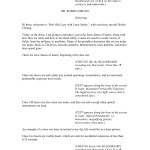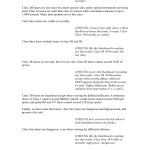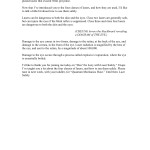Category Archives: Laser Safety
results: script. final project: movie. to come: theme song.
Project Research and Data- Laser Safety and Precautions
From Title 21, Volume 8 of the Code of Federal Regulations.
Part 1040 — Performance Standards for Light-emitting Products
Sec. 1040.10 Laser Products
(http://www.accessdata.fda.gov/scripts/cdrh/cfdocs/cfcfr/cfrsearch.cfm?fr=1040.10)
The following information will be used:
- Detailed descriptions of Class Levels
- Definitions (Collateral radiation, human access, integrated radiance, safety interlock, etc.)
- Federal regulations/guidelines for laser use/operation
- Several Cautions
J. Marshall, Br. J. Ophthalmol. 82, 1335 (1998).
- Why the eye is of primary interest in laser safety
- The three primary damage mechanisms of over(eye)exposure to laser light
- This is dependent on wavelength, pulse duration, and energy
- The history of laser safety and when codes of practice entered the laser realm
- This began within 5 years of the first demonstration of a laser, 1960
- Definitions
- Median Effective Dose (ED)
- Dose which results in irreversible retinal damage
- Maximum Permissible Exposure Levels (MPE)
- Maximum exposure length that results in no damage
- Median Effective Dose (ED)
- Layman descriptions of laser classes
- International concerns
- World Health Organisation (WHO)
- International Committee for Non-ionising Radiation Protection (ICNRP)
- International Electro-technical Comission (IEC)
- The development of laser pointers
- Beginning with early laser pointers:
- class 2 systems that used helium-neon laser sources with and emission wavelength at 632.8 nm
- Beginning with early laser pointers:
- International concerns
- Original intent of lasers for the public
- For use in lecture theaters or boardrooms
- The visual effect of making eye-contact with laser light
- In order of increasing brightness:
- Dazzle
- “After image” formation
- Flash blindness
- Irreversible damage
- In order of increasing brightness:
Dan Vergano. “Powerful laser pointers create risks: Lights deliver strong beams that can damage eyes.” USA TODAY 18 Nov. 2010
This article discusses the dangers of laser pointers sold via the internet. Points made are:
- These laser pointers contain greater strength than what is FDA approved, and the FDA only has jurisdiction over our producers and not our buyers
- Possible retinal damage (they cite the New England Journal of Medicine)
- Dangers of green colored laser pointers
- * this article is somewhat dramatized and contributes as a supporting element to the article by John Marshall
W. M. Steen and J. Mazumder, Laser Material Processing, 4th ed. (Springer, London, 2010).
- Chapter 13 of main interest
- Page 519 outlines main danger of lasers- damage to the eye, damage to the skin, electrical hazards, and fume hazards
- Danger to eye
- Damage to retina in back of eye and damage to cornea in front
- Radiation on retina focused by eye’s lens to amplify power by about 10^5 (100,000)
- Laser at the visible or near-visible waveband are much more dangerous compared to outside the band
- Eye damaged through explosive evaporation (cooking and boiling)
- Safe exposure limit indicated by maximum permissible exposure (MPE) levels
- Levels very low, especially as lasers become more powerful
- Danger to skin
- Laser classes 3R, 3B, and 4 are dangerous to the skin, with 3R least dangerous and 4 most dangerous
- Safety arrangements
- 1) Beam terminated with material able to withstand beam for several minutes
- 2) Stray reflections minimized
- 3) All personnel must wear goggles
- 4) Must seek approval for entry
- 5) Warning lights and hazard notices
- 6) Care taken in beam alignment
- 7) Laser safety officer to check on guidelines
- Electrical danger
- “A typical CO2 laser may have a power supply capable of firing the tubes with 30,000V with 400mA” (W. M. Steen and J. Mazumder 2010:525)
- Fatal discharge possible at this level
- Earthing system must be present
- “A typical CO2 laser may have a power supply capable of firing the tubes with 30,000V with 400mA” (W. M. Steen and J. Mazumder 2010:525)
- Fume danger
- High temperature of laser able to volatilise most materials, creating potentially dangerous fume
- Organic materials particularly dangerous; laser might create radical groups highly dangerous to people
A. L. McKenzie, J. Radiol. Prot. 8, 209 (1988)
- “It would seem that no organ of the body is immune from incision, resection, coagulation or ablation by laser” (McKenzie 1988:209)
- Laser types and characteristics
- Carbon dioxide laser
- 20-100 W of far-infrared (wavelength of 10.6 μm)
- Usually continuous, sometimes pulsed between several hundred and several thousand hertz
- Radiation at this level easily absorbed in water- explosive disruption of cells as water becomes steam (tissue ablation by vaporisation)
- Heat damage under the ablated surface is minimal
- Because of tissue coagulation between 60-80 degrees Celsius, tissue is denatured and blood vessels are constricted; bloodless operation
- Used in gynaecology procedures, especially treatment of cervical intra-epithelial neoplasia
- Argon lasers
- 3-6 W of blue-green light (usually several wavelengths at one time, usually 488 nm and 514.5 nm most common)
- Highly scattered, diffuses a few hundred microns below tissue; good for surface use such as coagulation
- Nd:YAG lasers
- Neodymium-doped yttrium aluminium garnet
- Nd:Y3Al5O12
- Near-infrared radiation (wavelength of 1.06 μm)
- Either continuous at 60-100 W or pulses at tens of nanoseconds at several mJ per pulse.
- When pulsed, known as Q switched lasers as opposed to continously working (cw) mode
- Either continuous at 60-100 W or pulses at tens of nanoseconds at several mJ per pulse.
- Beam scatters less than argon laser light, and absorbed less than carbon dioxide laser radiation
- Can coagulate more volume (several mm of soft tissue) than both argon and carbon dioxide lasers
- Neodymium-doped yttrium aluminium garnet
- Other lasers
- Krypton laser
- 647 nm or 568 nm; can be tuned to any wavelength in visible spectrum
- Krypton laser
- Carbon dioxide laser
- Eye hazard
- Sight impairment through retina, cornea, and/or lens damage
- Cataract induced by absorption of near-infrared or ultraviolet radiation
- Thermal damage present long before cataract, however
- Cornea affected by heat like egg white- will “cook” the cornea and create opaque patch where laser impacts
- Visible and near-infrared radiation at 1.06 μm can travel through ocular media to retina
- ~ 40% of Nd:YAG laser radiation hits retina; ¾ will be transmitted or reflected (only ~10% absorbed in retina)
- MPE
- Carbon dioxide- 560 t-0.75 mW cm-2
- Argon- 9 t-0.25 mW cm-2
- Nd:YAG- 1.8 t-0.25 mW cm-2
- Eye blink reflex time is usually cited as 0.25s
- Eye protection
- Different types of eye protection are needed for different types of lasers in medicine
- Other hazards
- Skin burns
- Maximum permissible exposure tables are also calculated for skin contact, like for eye contact
- Laser-proof protection is impractical to wear, however
- Safety controlled by prevention of skin contact instead
- Smoke
- “Smoke is produced when cell water has been removed from soft tissue, leaving the dried framework to char and burn” (McKenzie 1988:217)
- Fire
- Cited by Fisher as a greater hazard than eye injury (McKenzie 1988:217)
- Skin burns
- Laser theatre
- Windows need to be shielded according to power of laser
- Laser Protection Adviser and Laser Protection Supervisor (LPA and LPS)
- LPA in control of installation, training, and usage
- LPS a subordinate of LPA; in charge of supervision and observation of the rules
Project Plan
Roles:
Robin– Robin will be the actor in the film, and will also write the theme song for the presentation. The theme song will be a light-hearted take discussing lasers and laser science. Bianca– Bianca will be the cinematographer and the editor of the film. We will co-write the script, and also both conduct the necessary research.
Science/Technology:
Lasers will, unsurprisingly, play a main role as the technology within our film. The science behind how lasers can cause injury to body parts and why one should not play around with lasers will also be covered. Video editing software will be used for Bianca’s role in the project, and music editing software will be used for my portion of the project.
Activity Plan:
We will first write the script together, with filming occurring after we finish the script. The theme song’s lyrics will be written after the script is complete, but while the movie is being filmed and edited; the musical part will be constructed beforehand. The finished product will be a refined, produced short film highlighting why one shouldn’t play around lasers (along with why messing around with anything potentially dangerous is a bad, bad idea).
Outcome:
We hope that this project will be highly educational and teach the class about lasers and laser safety, while also being entertaining, interesting, and hopefully funny. Hopefully.
Don’t be Lazy with Laser Safety!
For our project we propose to make an educational science video in the style of Bill Nye the Science Guy. It will include a theme song and lesson about laser safety and precautions. In our video we plan to demonstrate the dangers of each class of lasers what safety measures are necessary to work with such.
Welcome!
This is the Student Project Group for Bianca Arias and Robin Cheung. This is the section of the LTT website where you should place all of your posts that relate to your group project. Once you have read the “How To Post” page and have decided upon a physics project for your group, you should follow along with the assignments listed in the Course Syllabus to know what should be posted here, and when. Remember that any comments on others’ work should not appear in this category, but should be made as comments underneath their respective posts. As soon as you finalize your project plans, keep up with the assignment due dates on Moodle, and have fun posting. Good luck!
Getting Started…
In order for you all to start blogging both independently and collaboratively, you will first need to review the guidelines for the required format of your posts and how your blog work will be assessed. To do this, look at the page titled “How To Post.” The tab for this page is listed in the bar above.




